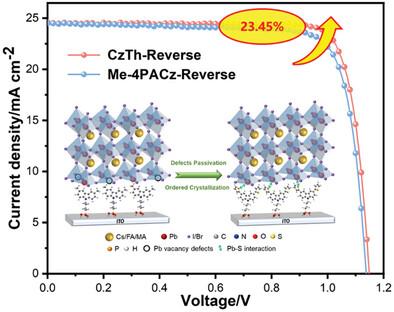Thiophene Substituent Engineering of Carbazole Based Self-Assembled Monolayers for Use in High-Performance Inverted Perovskite Solar Cells
IF 13
2区 材料科学
Q1 CHEMISTRY, MULTIDISCIPLINARY
引用次数: 0
Abstract
Carbazole-based self-assembled monolayers (SAMs) are widely used in inverted perovskite solar cells (PSCs). However, the biased intermolecular assembly of SAM molecules, and the lack of Lewis-basic heteroatoms to efficiently tune the crystallinity of perovskites and passivate the interface defects still limited the further improvement of the efficiency and stability for PSCs involving carbazole-based SAMs. Herein, a novel 3,6-dithiophene carbazole-based SAM molecule (named CzTh) is designed via the substituent engineering strategy, which is demonstrated to effectively solve the obstacles. The theory and experiment find that the introduction of thiophene regulated SAMs with the carbazole core in terms of surface wettability for precursor solvent, energy level alignment, the crystallization of perovskite films and defects passivation, which is attributed to dipole moment changes, and the Lewis base property of S atom. Consequently, the PSCs with CzTh achieved enhanced power conversion efficiency (PCE) and excellent air stability, compared to the commercial SAMs (Me-4PACz). As an “one-stone-three-birds” design strategy for SAMs, the “thiophene-substitution” effectively tunes the perovskite crystallization, passivates the defects, and enhances the hole injection at the perovskite/SAMs interface of inverted PSCs.

求助全文
约1分钟内获得全文
求助全文
来源期刊

Small
工程技术-材料科学:综合
CiteScore
17.70
自引率
3.80%
发文量
1830
审稿时长
2.1 months
期刊介绍:
Small serves as an exceptional platform for both experimental and theoretical studies in fundamental and applied interdisciplinary research at the nano- and microscale. The journal offers a compelling mix of peer-reviewed Research Articles, Reviews, Perspectives, and Comments.
With a remarkable 2022 Journal Impact Factor of 13.3 (Journal Citation Reports from Clarivate Analytics, 2023), Small remains among the top multidisciplinary journals, covering a wide range of topics at the interface of materials science, chemistry, physics, engineering, medicine, and biology.
Small's readership includes biochemists, biologists, biomedical scientists, chemists, engineers, information technologists, materials scientists, physicists, and theoreticians alike.
 求助内容:
求助内容: 应助结果提醒方式:
应助结果提醒方式:


